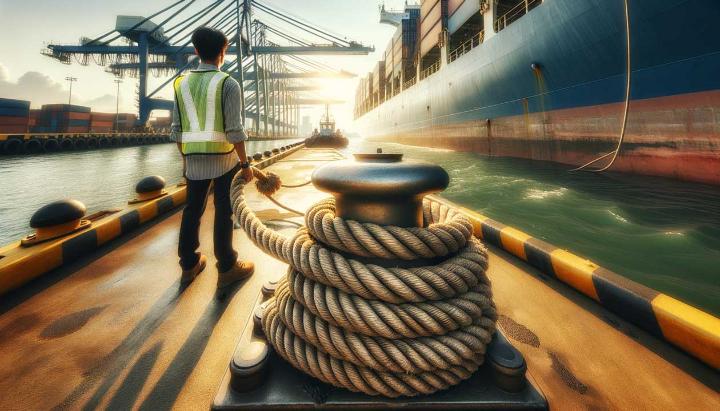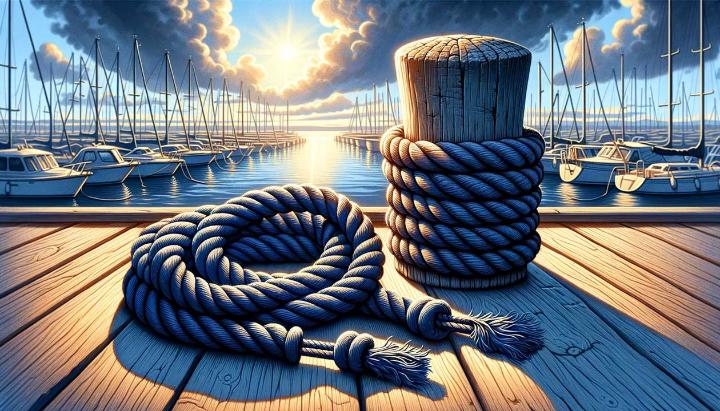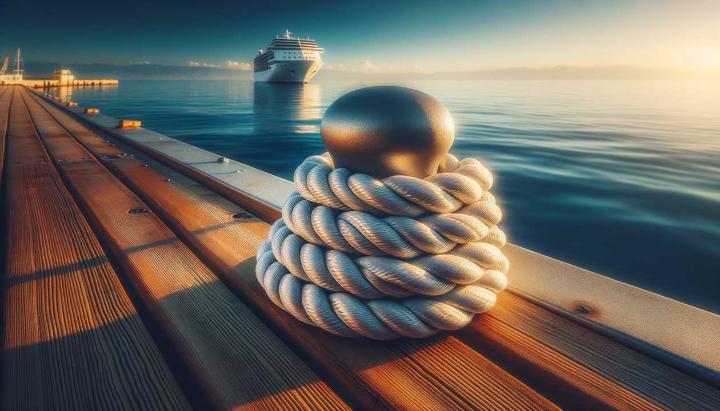Have you ever wondered what keeps massive ships securely in place, even in the roughest seas? The answer lies in the unsung heroes of maritime safety: mooring ropes. These seemingly simple yet technologically advanced tools are the lifelines that prevent multimillion-dollar vessels from drifting away or colliding in ports worldwide. But not all mooring ropes are created equal.
In the high-stakes world of maritime operations, where a single failure can lead to catastrophic consequences, mastering the art of mooring tail techniques and splicing mooring rope is paramount. This is where iRopes, a leading manufacturer of premium mooring solutions, steps in to revolutionise the industry.
As we dive into the intricate world of mooring ropes, we'll uncover the secrets behind crafting the perfect mooring tail and the precision required for expert rope splicing. Whether you're a seasoned mariner or a curious landlubber, this guide will equip you with the knowledge to appreciate the complexity and importance of these critical maritime components.
Join us as we explore how iRopes is setting new standards in the industry, offering bespoke mooring tails and specialised mooring rope splicing services that ensure the safety of vessels and crew alike. Discover why choosing the right mooring rope isn't just a matter of strength, but a delicate balance of durability, flexibility, and cutting-edge design that could make all the difference when nature unleashes its fury.
Understanding Mooring Rope: Essential Components of Maritime Operations
When it comes to securing vessels in ports, harbours, or offshore installations, mooring ropes play a crucial role in maritime operations. These robust lines are the unsung heroes of the nautical world, ensuring that ships remain safely in place amidst changing tides, winds, and currents. Let's dive into the world of mooring ropes and discover why they're so essential for vessel security and maritime safety.
Types of Mooring Ropes and Their Applications
Mooring ropes come in various types, each designed to meet specific needs and environmental conditions. The three main categories you'll encounter are:
- Chain mooring lines: Incredibly strong and durable, ideal for long-term moorings in harsh conditions.
- Wire ropes: Offer a balance of strength and flexibility, suitable for larger vessels and offshore applications.
- Synthetic fiber ropes: Lightweight and easy to handle, perfect for smaller boats and temporary moorings.
Each type has its unique advantages, and the choice often depends on factors like vessel size, mooring duration, and local weather patterns. For instance, a large cargo ship in a busy port might use a combination of wire and synthetic ropes for optimal security and ease of handling.
Selecting the Right Mooring Line for Your Vessel
Choosing the appropriate mooring rope is crucial for ensuring your vessel's safety. Here are some key factors to consider:
- Vessel size and weight
- Expected weather conditions
- Mooring duration
Remember, the right mooring line should offer the perfect balance of durability, flexibility, and grip. UV resistance is also crucial for ropes exposed to harsh sunlight. At iRopes, we understand these nuances and offer a range of high-quality mooring ropes tailored to various maritime needs.
Have you ever wondered why some mooring arrangements look more complex than others? The mooring setup can vary significantly based on the vessel type and size. A small pleasure craft might use a simple fore and aft mooring, while a large tanker could require an intricate pattern of breast lines, spring lines, and bow and stern lines to distribute forces evenly.
By understanding the essentials of mooring ropes, you're taking the first step towards ensuring safer and more efficient maritime operations. Whether you're a seasoned captain or a novice boater, choosing the right mooring rope is crucial for your vessel's security and your peace of mind.
Mastering Mooring Tail Techniques
As we delve deeper into the world of maritime safety, it's crucial to understand the unsung heroes of ship mooring: mooring tails. These vital components play a pivotal role in ensuring vessel security and preventing costly accidents. Let's explore the intricacies of mooring tails and how mastering their techniques can elevate your maritime operations.
What is a Mooring Tail?
A mooring tail, often referred to as a pennant or pendant, is a short length of rope attached to the end of a mooring line. This seemingly simple addition serves a critical purpose in the mooring system. Have you ever wondered why ships don't simply use a single, long mooring line? The answer lies in the unique properties of mooring tails.

Benefits of Using Mooring Tails
The advantages of incorporating mooring tails into your mooring setup are numerous:
- Enhanced shock absorption: Mooring tails act as a buffer, absorbing sudden jerks and reducing stress on the main mooring line.
- Increased elasticity: The tail's flexibility allows for better load distribution, minimising wear and tear on both the vessel and the mooring point.
- Improved safety: By reducing the risk of line snapback, mooring tails significantly enhance crew safety during mooring operations.
- Extended lifespan: The use of tails can prolong the life of your main mooring lines, offering a cost-effective solution in the long run.
Proper Mooring Tail Attachment Techniques
Attaching mooring tails correctly is paramount to their effectiveness. Here's a step-by-step guide to ensure you're following best practices:
- Inspect the tail and main line for any signs of damage or wear.
- Align the tail with the main line, ensuring there are no twists or kinks.
- Use a proper splicing technique or an approved coupling method to join the tail to the main line.
- Double-check all connections and ensure the tail is securely fastened.
- Test the setup under controlled conditions before relying on it in actual mooring situations.
Remember, the strength of your mooring system is only as good as its weakest link. Proper attachment is crucial for maintaining the integrity of your mooring arrangement.
Tips for Selecting the Right Mooring Tail
Choosing the appropriate mooring tail can be a game-changer for your vessel's safety. Consider these factors when making your selection:
Key Factors in Mooring Tail Selection
Material, length, diameter, and breaking strength
- Material matters: Opt for high-quality synthetic fibres like nylon or polyester for optimal performance.
- Length considerations: Typically, mooring tails should be 11 metres long, as per MEG4 guidelines.
- Diameter decisions: Ensure the tail's diameter is compatible with your vessel's fairleads and bitts.
- Breaking strength: The tail's breaking strength should be 25-30% lower than the main line to act as a sacrificial weak link.
By carefully considering these factors, you'll be well on your way to creating a robust and reliable mooring system. Remember, at iRopes, we specialise in crafting custom mooring tails tailored to your specific needs, ensuring you have the perfect solution for your vessel.
Mastering mooring tail techniques is an ongoing process, but with the right knowledge and equipment, you'll be well-equipped to handle any mooring challenge that comes your way. Stay tuned for our next section, where we'll dive into the art of splicing mooring ropes!
Splicing Mooring Rope: Essential Techniques
Have you ever marvelled at the intricate web of ropes securing a massive vessel to the dock? The secret behind those robust connections lies in the art of splicing mooring rope. As a seasoned mariner, I've come to appreciate the critical role that proper splicing plays in ensuring the safety and longevity of mooring systems.
Splicing is more than just joining two pieces of rope together; it's about creating a seamless, strong connection that can withstand the relentless forces of wind and tide. Unlike knots, which can significantly weaken a rope, a well-executed splice maintains up to 90% of the rope's original strength. This is why mastering splicing techniques is essential for anyone serious about maritime safety.
Types of Mooring Rope Splices
In my years working on various vessels, I've encountered several types of splices, each serving a unique purpose in mooring applications:
- Eye splice: Creates a loop at the end of the rope, perfect for attaching to cleats or bollards.
- Back splice: Prevents the end of the rope from fraying, ideal for mooring lines that see frequent use.
- Cut splice: Joins two ropes together, useful for repairing damaged mooring lines without replacing the entire length.
While knots might seem like a quick fix, they simply can't match the strength and reliability of a proper splice. I've seen firsthand how a well-spliced mooring line can outlast its knotted counterparts by years, saving time and money in the long run.

Step-by-Step Guide to 8-Strand Eye Splice
Let's walk through creating an 8-strand eye splice, a common and versatile splice used in mooring applications. Before we begin, gather these essential tools:
- Splicing fid: A tapered tool used to separate strands and guide them through the rope.
- Marlinspike: Helps to tighten and shape the splice.
- Sharp knife: For cutting and trimming rope strands.
- Whipping twine: To secure the splice and prevent fraying.
- Tape measure: Ensures accurate measurements for a balanced splice.
Now, let's dive into the splicing process:
- Measure and mark the rope where you want the eye to begin, typically about 20 times the rope's diameter from the end.
- Unlay the strands back to this mark, separating them into two groups of four.
- Form the eye by bringing the rope end back to the marked point, creating a loop.
- Using your splicing fid, weave each strand from one group over one and under one of the main rope strands.
- Repeat this process with the remaining strands, following the "over one, under one" pattern.
- After completing one full pass, continue weaving each strand for two more tucks.
- Taper the splice by cutting away half the yarns in each strand before making the final tuck.
- Use the marlinspike to tighten and shape the splice, ensuring all strands are snug.
- Trim any excess strands and whip the ends of the splice with twine for a clean finish.
Remember, practice makes perfect. Your first few splices might look a bit rough, but with time and patience, you'll be creating professional-grade splices that can withstand the toughest maritime conditions.
As you master this technique, keep in mind some common pitfalls to avoid:
- Inconsistent tension: Ensure each strand is pulled equally tight to maintain the splice's strength.
- Incorrect counting: Always double-check your "over one, under one" pattern to avoid weak points.
- Rushing the process: Take your time, especially when working with larger diameter ropes.
- Neglecting the finish: A properly whipped end not only looks professional but also extends the life of your splice.
By mastering the art of splicing mooring rope, you're not just learning a skill; you're becoming a guardian of maritime safety. Whether you're securing a small pleasure craft or a massive cargo ship, the strength and reliability of your splices will play a crucial role in keeping vessels safe and secure in any harbor. For more detailed guidelines on mooring ropes, check out our Essential Guide to Selecting Mooring Ropes for Ships and Yachts.
At iRopes, we understand the importance of proper splicing techniques. That's why we offer not only top-quality mooring ropes but also expert guidance on splicing and maintenance. Our commitment to maritime safety extends beyond our products to ensuring that our customers have the knowledge and skills to use them effectively.
iRopes: Leading Manufacturer of Trusted Mooring Ropes
When it comes to securing your vessel, the importance of reliable mooring solutions cannot be overstated. That's where iRopes comes in. With years of experience in the maritime industry, we've established ourselves as a trusted manufacturer of high-quality mooring ropes that stand up to the toughest conditions at sea.
Have you ever wondered what sets a premium mooring rope apart from the rest? It's not just about strength; it's about durability, flexibility, and innovative design. At iRopes, we pride ourselves on crafting mooring solutions that tick all these boxes and more. Explore why top mooring rope manufacturers rely on iRopes' high-quality solutions.
High-Quality Mooring Solutions for Marine Vessels
Our mooring ropes are engineered to withstand the harsh marine environment, offering unparalleled strength and longevity. But what exactly makes our ropes stand out in a sea of options?
- Superior strength-to-weight ratio: Our ropes offer maximum holding power without the bulk, making handling easier for your crew.
- UV and abrasion resistance: Engineered to withstand prolonged exposure to sunlight and rough surfaces, extending the lifespan of your mooring lines.
- Excellent shock absorption: Reduces sudden load impacts, protecting both your vessel and the mooring point from damage.
Typically, a high-quality mooring rope can last anywhere from 3 to 7 years, depending on usage and environmental factors. At iRopes, we've seen our ropes exceed these expectations time and time again, providing reliable service even in the most demanding conditions. Learn more about the key benefits of using nylon mooring rope from iRopes.

From small pleasure crafts to massive oil tankers, our mooring solutions cater to a wide range of marine vessels. We've supplied ropes for container ships navigating busy ports, cruise liners docking in tropical paradises, and offshore platforms battling fierce North Sea storms. Each application presents unique challenges, and our ropes are designed to meet them head-on.
Innovative Rope Technologies: Polypropylene vs Nylon
At iRopes, we understand that different mooring situations call for different rope materials. That's why we offer a variety of options, including polypropylene and nylon ropes. But how do these materials stack up against each other?
- Nylon ropes: Known for their exceptional strength and elasticity, nylon ropes are ideal for situations where shock absorption is crucial. They're also highly resistant to abrasion, making them perfect for rough mooring conditions.
- Polypropylene ropes: These ropes float on water, making them easier to handle in marine environments. While they offer less give than nylon, their resistance to water absorption makes them a popular choice for many applications.
But we don't stop there. At iRopes, we're always pushing the boundaries of rope technology. Have you heard of Dyneema® ropes? These advanced synthetic ropes are taking the maritime world by storm, offering strength that rivals steel wire rope at just 15% of the weight. It's innovations like these that keep us at the forefront of the mooring rope industry.
Did you know? Dyneema® ropes are so strong and lightweight that they're not only used in maritime applications but also in bulletproof vests and even spacecraft tethers!
At iRopes, we're not just selling ropes; we're providing peace of mind. Whether you're looking for a standard mooring line or a custom solution tailored to your specific needs, we've got you covered. Our team of experts is always ready to help you choose the perfect mooring rope for your vessel, ensuring your safety and satisfaction on the water.
Ready to upgrade your mooring equipment? Explore our range of high-quality mooring ropes and experience the iRopes difference for yourself. Your vessel deserves nothing but the best, and that's exactly what we deliver
Discover the essential role of high-quality mooring rope in maritime operations, and learn how mastering mooring tail techniques and splicing mooring rope can enhance vessel security and longevity. iRopes is your trusted manufacturer, offering tailored solutions, including custom mooring tails and expert splicing services. Our extensive range of products ensures safety and durability for all marine applications.
Get Your Custom Mooring Rope Solutions Today
Fill out the form above to learn how iRopes can provide you with the perfect mooring rope splicing and mooring tail solutions to meet your specific needs!